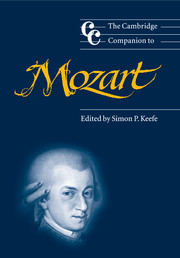Book contents
- Frontmatter
- Introduction
- Part I Mozart in context
- Part II The works
- 5 The keyboard music
- 6 The concertos in aesthetic and stylistic context
- 7 The orchestral music
- 8 Mozart's chamber music
- 9 Mozart as a vocal composer
- 10 The opere buffe
- 11 Mozart and opera seria
- 12 Mozart's German operas
- Part III Reception
- Part IV Performance
- Notes
- Selected further reading
- General index
- Index of Mozart’s works
9 - Mozart as a vocal composer
from Part II - The works
Published online by Cambridge University Press: 28 September 2011
- Frontmatter
- Introduction
- Part I Mozart in context
- Part II The works
- 5 The keyboard music
- 6 The concertos in aesthetic and stylistic context
- 7 The orchestral music
- 8 Mozart's chamber music
- 9 Mozart as a vocal composer
- 10 The opere buffe
- 11 Mozart and opera seria
- 12 Mozart's German operas
- Part III Reception
- Part IV Performance
- Notes
- Selected further reading
- General index
- Index of Mozart’s works
Summary
In a memorable scene from Peter Shaffer's Amadeus, Salieri is introduced to Mozart's music through a performance of the Adagio from the Serenade for Winds in B flat major, K.361. It causes him to swoon: ‘It seemed to me that I had heard a voice of God,’ Salieri exclaims in a mixture of admiration and bitterness, ‘and that it issued from a creature whose own voice I had also heard – and it was the voice of an obscene child!’ (Act 1, scene 5). Although Shaffer's play takes many poetic liberties with historical facts, this remark reflects much of the nineteenth- and twentieth-century reception of Mozart: a child prodigy (or idiot savant) who never grew up, yet wrote inspired, virtually perfect music. This comment put in the fictional Salieri's mouth also makes clear that Mozart's melodic gift is not limited to vocal music; indeed, for Shaffer you are as likely to hear the ‘voice of God’ in one of his secular instrumental works as in Mozart's sacred vocal music.
In fact, vocal music was of great importance to Mozart, and he was a gifted composer for the human voice. In the hierarchy of music before 1800, vocal genres – opera, oratorio and cantatas – reigned supreme, while even the loftier forms of orchestral music – symphonies and concertos – took a subordinate place. The main problem was summed up in Fontanelle's oft-repeated question: how could a sonata express an Affekt or emotion without words to guide the performer and listener? Vocal music and professional singers enjoyed a prestige that simply was not yet available to instrumental music.
- Type
- Chapter
- Information
- The Cambridge Companion to Mozart , pp. 118 - 130Publisher: Cambridge University PressPrint publication year: 2003
- 1
- Cited by



